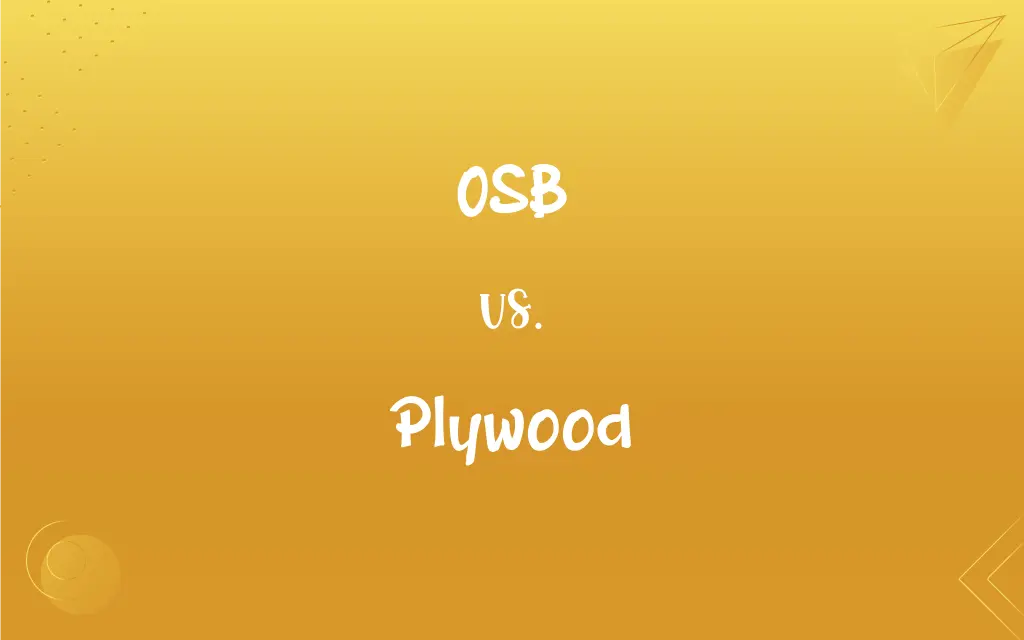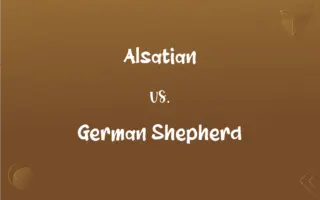OSB vs. Plywood: What's the Difference?
Edited by Harlon Moss || By Janet White || Published on March 1, 2024
OSB (Oriented Strand Board) is made from pressed wood strands; Plywood consists of thin wood layers glued together.

Key Differences
OSB (Oriented Strand Board) and Plywood are both engineered wood products widely used in construction. OSB is made by compressing and bonding wood strands with adhesives into a solid panel, providing a consistent strength across the board. Plywood, however, is crafted from thin layers of wood veneer that are glued and pressed together, with each layer's grain oriented perpendicular to adjacent layers for enhanced strength.
Plywood offers a slightly higher strength due to its cross-grain pattern, making it more resistant to splitting and providing a smoother surface for finishes. OSB's strength lies in its uniformity and size availability, often making it a more cost-effective choice for sheathing and roofing. Both materials have their specific uses, with plywood preferred in situations where moisture exposure is likely due to its superior resistance to delamination.
In terms of moisture resistance, OSB has improved significantly, with many modern OSB panels engineered to resist water better than older versions. However, Plywood still generally performs better in prolonged exposure to moisture, making it the preferred choice for projects where water resistance is crucial. OSB's larger panels are advantageous for reducing the number of joints in large areas, which can benefit structural integrity and installation speed.
Environmental considerations also differentiate the two, with OSB often seen as more sustainable due to its use of wood by-products and fast-growing species. Plywood's requirement for larger, quality logs can impact its environmental footprint. Despite these differences, both OSB and Plywood play vital roles in construction, with the choice between them depending on cost, structural requirements, and exposure conditions.
Comparison Chart
Composition
Made from compressed wood strands.
Made from layers of wood veneer.
ADVERTISEMENT
Strength
Strong, with uniform strength across the board.
Slightly stronger due to cross-grain layers.
Moisture Resistance
Has improved but generally less than Plywood.
Better moisture resistance.
Cost
Generally more cost-effective.
Usually more expensive.
Environmental Impact
Often considered more sustainable.
Requires larger logs, impacting sustainability.
OSB and Plywood Definitions
OSB
OSB panels are large, making them suitable for various construction projects.
We covered the roof with large OSB panels to speed up the installation.
ADVERTISEMENT
Plywood
Plywood is made from thin layers of wood veneer glued together.
The cabinet maker preferred plywood for its smooth surface.
OSB
Oriented Strand Board is known for its strength and uniformity.
OSB provides a sturdy base for the flooring installation.
Plywood
Plywood is renowned for its versatility in construction and furniture making.
We used Plywood for both the subflooring and the custom shelving.
OSB
Modern OSB is engineered to be more moisture-resistant.
The new OSB on the market is much better at resisting water damage.
Plywood
Plywood offers superior resistance to moisture and delamination.
For the bathroom remodel, we chose Plywood because of its moisture resistance.
OSB
OSB is often chosen for its environmental sustainability.
Choosing OSB helps reduce waste by utilizing wood by-products efficiently.
Plywood
Each layer in Plywood is arranged with its grain at right angles to the adjacent layer.
Plywood's cross-grain pattern adds to its strength and stability.
OSB
OSB is a type of engineered wood made from compressed wood strands.
The contractor decided to use OSB for the wall sheathing due to its cost-effectiveness.
Plywood
Plywood is available in various grades, suitable for different finishes and applications.
I selected high-grade Plywood for a smooth, paintable surface.
Plywood
A structural material made of layers of wood glued together, usually with the grains of adjoining layers at right angles to each other.
Plywood
(uncountable) Construction material supplied in sheets, and made of three or more layers of wood veneer glued together, laid up with alternating layers having their grain perpendicular to each other.
After the hurricane there was a severe regional shortage of plywood, especially exterior plywood.
Plywood
(countable) A specific grade or type of this construction material.
We stock exterior plywoods, interior plywoods, and furniture plywoods.
Plywood
(transitive) To fit or block up with plywood.
Plywood
A laminate made of thin layers of wood
FAQs
Is Plywood more expensive than OSB?
Generally, Plywood is more expensive than OSB.
What is Plywood used for?
Plywood is used in a wide range of applications, from construction sheathing to furniture.
What is OSB used for?
OSB is commonly used for sheathing in walls, flooring, and roof decking.
What are the environmental impacts of using OSB?
OSB is often viewed as more sustainable due to its use of wood by-products.
Which is more moisture resistant, OSB or Plywood?
Plywood is typically more moisture resistant.
Can OSB be painted?
Yes, but it may require more preparation compared to Plywood.
Why choose Plywood for furniture?
Its smooth surface and strength make it ideal for furniture.
Can OSB be used in place of Plywood?
Yes, in many cases, OSB can substitute Plywood, depending on the project's requirements.
How does Plywood's environmental impact compare to OSB?
Plywood requires larger, quality logs, which can have a greater environmental impact.
How do I prepare OSB for painting?
Sand the surface smooth and apply a primer designed for OSB.
Can both OSB and Plywood be used for outdoor projects?
Yes, but they should be properly treated or selected for outdoor use.
Is OSB suitable for flooring?
Yes, especially when used as a subfloor or underlayment.
Can OSB be used for load-bearing walls?
Yes, when installed correctly, OSB can be used for load-bearing applications.
Are there waterproof versions of OSB and Plywood?
Both materials have versions treated for enhanced moisture resistance.
Is Plywood stronger than OSB?
Plywood is considered slightly stronger due to its layered construction.
What should be considered when choosing between OSB and Plywood?
Consider factors such as cost, strength, moisture resistance, and the specific project requirements.
What's the best way to cut Plywood without splintering?
Use a sharp, fine-toothed saw blade and tape the cut line to minimize splintering.
How does Plywood perform under heavy loads?
Its cross-grained layers provide excellent strength and stability.
What sizes do OSB panels come in?
OSB panels are available in large sizes, typically up to 8 feet by 24 feet.
Are there different types of Plywood?
Yes, Plywood comes in various grades and types for different applications.
About Author
Written by
Janet WhiteJanet White has been an esteemed writer and blogger for Difference Wiki. Holding a Master's degree in Science and Medical Journalism from the prestigious Boston University, she has consistently demonstrated her expertise and passion for her field. When she's not immersed in her work, Janet relishes her time exercising, delving into a good book, and cherishing moments with friends and family.
Edited by
Harlon MossHarlon is a seasoned quality moderator and accomplished content writer for Difference Wiki. An alumnus of the prestigious University of California, he earned his degree in Computer Science. Leveraging his academic background, Harlon brings a meticulous and informed perspective to his work, ensuring content accuracy and excellence.































































